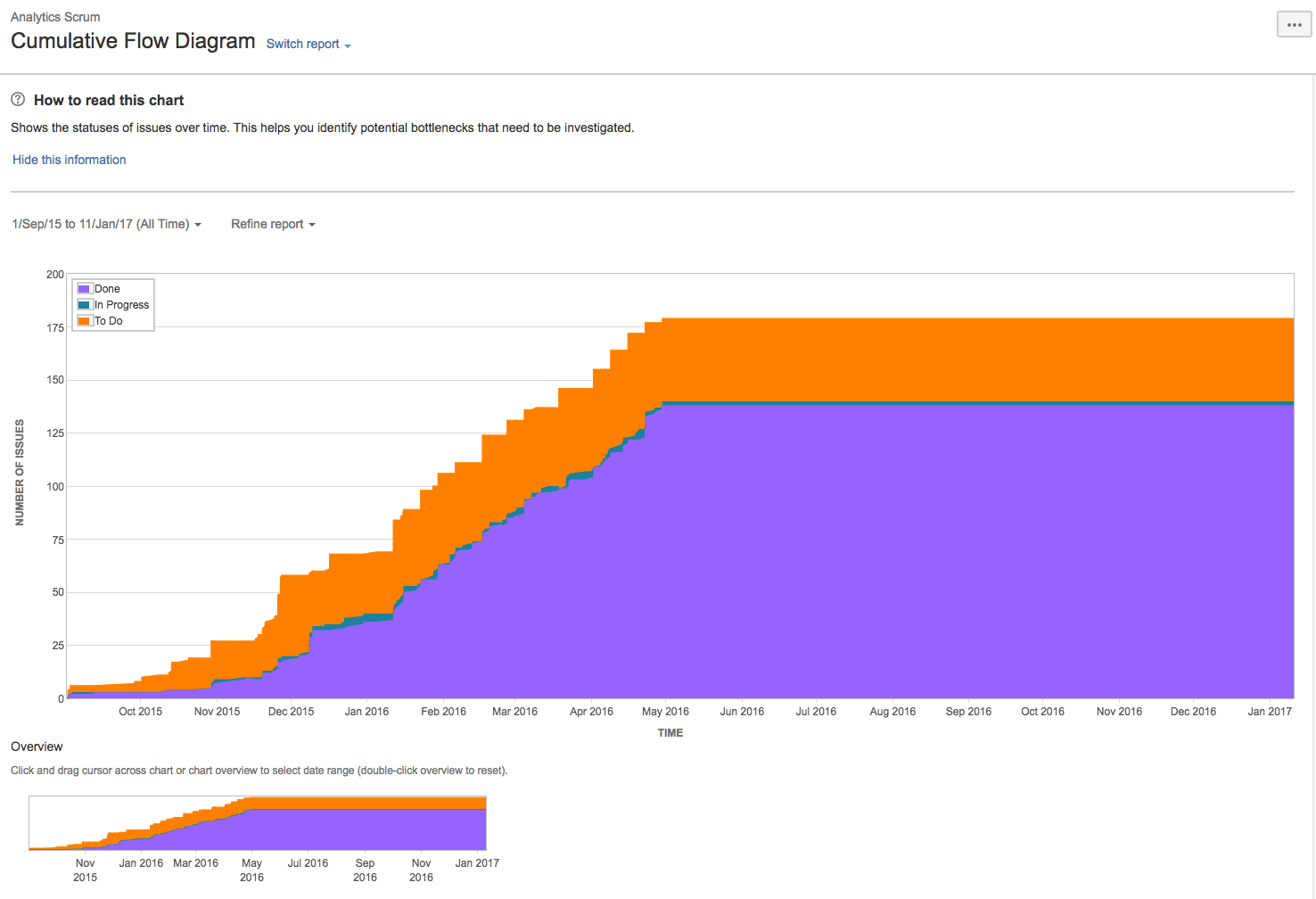FAQs
Viewing the cumulative flow diagram
What type of information can be seen in a cumulative flow diagram? ›
The vertical axis of the Cumulative Flow Diagram shows how many tasks are in each stage of the workflow process, while the horizontal axis displays these tasks over a given period of time. Information such as backlogged tasks, work in progress, and work completed are easily seen within the diagram.
How to read a CFD report? ›
The CFD shows the count of items in each column for the selected time period. From this chart, you can gain an idea of the amount of work in progress and lead time. Work in progress counts unfinished requirements. Lead time indicates the amount of time it takes to complete a requirement once work has started.
What is cumulative flow diagram in Azure Devops? ›
You use cumulative flow diagrams (CFD) to monitor the flow of work through a system. The two primary metrics to track, cycle time and lead time, can be extracted from the chart. To configure or view CFD charts, see Configure a cumulative flow chart.
What can you learn from a cumulative flow diagram safe? ›
In short, with CFD, you can learn about the progress made against backlogs. Also, you can know about the work done, work in progress, and the throughput over the cycle time.
How do you explain a flow diagram? ›
Flow diagrams, also known as flowcharts, are powerful tools for optimizing the paths - or flow - of people, objects or information through a system or procedure. The connectors and symbols work together to create a visual representation of the direction of movement and what's needed to make that movement happen.
What information can you learn from a flow diagram? ›
When designing and planning a process, flowcharts can help you identify its essential steps and simultaneously offer the bigger picture of the process. It organises the tasks in chronological order and identify them by type, e.g. process, decision, data, etc.
What does a flow diagram use to show information? ›
An information flow diagram (IFD) is a diagram that shows how information is communicated (or "flows") from a source to a receiver or target (e.g. A→C), through some medium. The medium acts as a bridge, a means of transmitting the information. Examples of media include word of mouth, radio, email, etc.
What information does a flow diagram provide? ›
A data flow diagram (DFD) maps out the flow of information for any process or system. It uses defined symbols like rectangles, circles and arrows, plus short text labels, to show data inputs, outputs, storage points and the routes between each destination.
What can CFD tell you? ›
Computational fluid dynamics (CFD) is the science of using computers to predict liquid and gas flows based on the governing equations of conservation of mass, momentum, and energy. Fluids are all around us and sustain our lives in endless ways.
Computational fluid dynamics (CFD) is used to analyze different parameters by solving system of equations such as fluid flow, heat transfer, etc. equation with the help of a computer system. It is used in variety of applications.
How do you Analyse CFD? ›
In further detail, these steps include:
- Formulate the Flow Problem. ...
- Model the Geometry and Flow Domain. ...
- Establish the Boundary and Initial Conditions. ...
- Generate the Grid. ...
- Establish the Simulation Strategy. ...
- Establish the Input Parameters and Files. ...
- Perform the Simulation. ...
- Monitor the Simulation for Completion.
The horizontal x-axis in a CFD indicates time, and the vertical y-axis indicates cards (issues). Each colored area of the chart equates to a workflow status (i.e. a column on your board). The CFD can be useful for identifying bottlenecks.
What can you easily see on a cumulative flow diagram? ›
Cumulative flow diagrams will visualize inefficiencies in your project timeline when your team has too much or too little work in progress at any given point. Throughput: This is the number of tasks your team can complete over a given period.
What type of information does a cumulative flow diagram provide? ›
The cumulative flow diagram will show you how stable your flow is. It displays any weaknesses and provides you with actionable advice for continuous improvement.
How do you read a cumulative chart? ›
Each line is a count of the number of tickets moving through that part of the process – stacked on top of one another, hence the name “cumulative”. Along the x-axis are the days – it's quite common for CFDs to use days as the point of measurement. Along the y-axis is the count of the tickets.
How do you read a flow diagram? ›
Flow charts tend to consist of four main symbols, linked with arrows that show the direction of flow:
- Elongated circles, which signify the start or end of a process.
- Rectangles, which show instructions or actions.
- Diamonds, which highlight where you must make a decision.
- Parallelograms, which show input and output.
The horizontal distance between your first and last stage shows the approximate average cycle time for your tasks meaning the time it took you to progress a task from being Requested to Done. When all the bands are progressing in parallel, this means that your process is smooth and the cycle time is consistent.
Which curve does a cumulative flow diagram focus on? ›
A Cumulative Flow Diagram (CFD) is one common tool used to effectively visualize flow load over time (Figure 9). The CFD shows the quantity of work in a given state, the rate at which items are accepted into the work queue (arrival curve), and the rate at which they are completed (departure curve).
